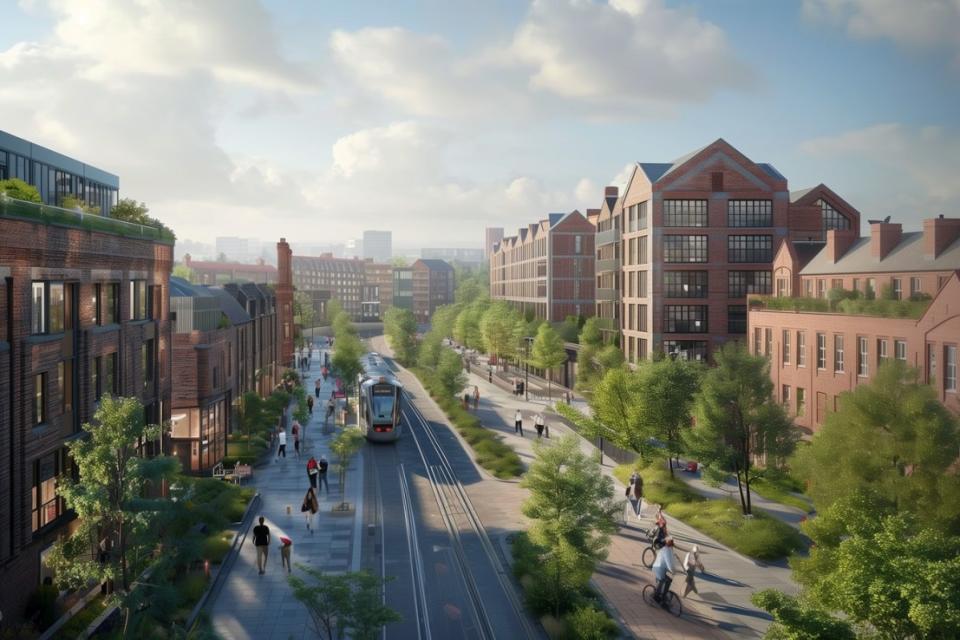Labour’s ‘everything bagel’ approach to housing leaves a sour taste

If Labour isn’t offering a serious overhaul of planning regulations to force through new housing it has no business touting images of beautiful townscapes that are illegal to build, says Henry Hill
Last week, Labour launched its big offer on housing. As is now becoming the norm, it was accompanied by lots of pretty pictures. But where Michael Gove left it to enthusiastic Yimbys to create AI visions of his New Cambridge, Angela Rayner went to the professionals.
The resulting “sketched illustrative vision” in Create Streets’ short report, Becoming a Nation of Townbuilders, are very appealing. I’m sure millions of Brits would love to live in the sort of communities they depict.
But there’s a reason we don’t build them, and it isn’t (just) because an oligopoly of big developers don’t need to put in nearly so much effort to sell homes in an acute shortage. No, it’s because many of the design features that make the illustrated streets so appealing are illegal.
Sash windows? Banned. Big windows? Also banned, and super-banned in London. Windows less than 1.2m off the floor? Banned.
Steps up to the front door? Banned, even on private houses, unless you have a wheelchair-accessible ramp tucked away at the back. Attractive, wrought-iron railings of the sort that dignify many an historic façade? Banned – they need to be much higher and have the railings much closer together.
Chimneys? A nice touch, but developers haven’t built chimneys in years. A proper fire in most towns and cities? Banned.
This is by no means the biggest question mark over Labour’s proposals. Much more serious are the opposition’s unhelpful insistence on what’s called an ‘everything-bagel’ approach, and an apparent lack of willingness to actually force development through.
As stated, Labour’s plan is for new developments to be beautiful (i.e. more expensive to build), affordable (i.e. sell below market prices), free (i.e. built by the private sector) and to increase biodiversity net gain, all at once.
Things get even more onerous when it comes to Sir Keir Starmer’s so-called ‘grey belt’. The idea of freeing up unlovely parts of the green belt for development is good – but Labour has promised to freight such sites with even higher regulatory and affordability burdens, which won’t incentivise developers to undertake the often-expensive work of preparing a brownfield site.
All that is if any projects actually take shape, of course. Contra some headlines, Labour does not propose to ‘decide’ where new towns are going. It is going to set up a quango (of course) and invite councils to bid to have their planning powers handed over to a development corporation.
Why would they? For that matter, why would local Labour councillors be any more willing to develop Sir Keir’s go-to example of the grey belt (a disused petrol station in Tottenham) under a new label than the current one? They already have the power to let someone develop the site; they don’t want to.
But the building beautiful report seems to come closest to actual deceit. If Labour isn’t planning a serious overhaul of the building regulations, it has no business touting beautiful illustrations of illegal townscapes which, according to one expert, would require “a listed building exemption” and “permission from a local heritage officer” for every last building.
A proper overhaul of the building regulations is much-needed and long-overdue. It is absurd that century-old property commands a substantial price premium in the housing market – but it will continue to do so if buying a period property remains the only way to live in the sort of property millions of people clearly prefer to live in.
Yet that would mean a head-on confrontation with our national disease: regulating for the perfect at the expense of the good. Personally, I can’t see Rayner making a level case for reducing accessibility and safety requirements, however ill-judged and cost-ineffective they might be.
Henry Hill is acting editor of Conservativehome

 Yahoo Finance
Yahoo Finance 